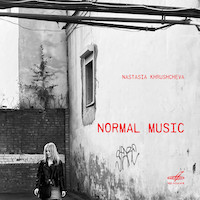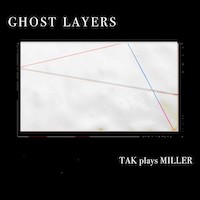Ramble, with Skeletons
|
Grant Chu Covell [May 2022.]
“Speed Dating.” Mark APPLEBAUM: Three Unlikely Corporate Sponsorships (2016)1; Skeletons in the Closet (2009)2; Speed Dating (2014)3; The Plate of Transition Nourishes the Chameleon Appetite (1992; rev. 1994)4; Clicktrack (2015)5. Mark Applebaum1 (voice), Stony Brook Contemporary Chamber Players3, Eduardo Leandro3 (cond.), Takao Kyakutome4 (vln), Southern Oregon University Percussion Ensemble5, Terry Longshore5 (cond.). Innova 996 (1 CD) (www.innova.mu). Applebaum elegantly demonstrates that composition is often about balancing effort and result. Three Unlikely Corporate Sponsorships virtuosically explores a genre of sound poetry recalling Charles Amirkhanian’s work. Words are precisely arranged and layered to find new relationships in synonyms and syllables, leveraging rhythms and repetition. Puns are rife, and Applebaum introduces a political subtext. Skeletons in the Closet uses an algorithm to play samples from eight analog synthesizers, the skeletons in Applebaum’s closet. Yesterday’s blippy sounds appear in bursts, with some repetitions. Speed Dating asks an instrumental octet (flute, clarinet, trombone, percussion, piano, violin, cello, bass) to rapidly pair and recombine. The music is frenetic. The Plate of Transition Nourishes the Chameleon Appetite suggests something immensely complicated and serious, and perhaps it is, as a solo violin whittles and busies. But perhaps there is a joke here, hinted at in Speed Dating, that a maximal sound can sometimes be achieved though simpler means and with readily available materials. Clicktrack for three percussion quartets has the players listening to pre-recorded poetry and responding as per the score. We do not hear the underlying score, but a soft haze of spoken words and assorted noises.
“Normal Music.” Nastasia KHRUSHCHEVA: The Book of Grief and Joy (2019)1; Trio in Memory of a Non-Great Artist (2014)2; Russian Dead-Ends-3 (2021)3. Nastasia Khrushcheva1,2,3 (pno), Stanislav Malyshev2 (vln), Olga Kalinova2 (vlc), OpensoundOrchestra1, Stanislav Malyshev1 (cond.). Melodiya MEL CD 10 02666 (1 CD) (www.melody.su). A welcome twist through approachable minimal territory. Minimalism and repetition are often consigned together, however, the raw ingredients make all the difference. Khrushcheva’s material hints at the past, specifically Russian music whose phrases and cadences populate the repetitions and anchor her minimalist patterns. The inform us that Khrushcheva’s sources are Russian, but they could just as well be standard issue Baroque, Classical or Romantic gestures and motifs. The Book of Grief and Joy for string orchestra and piano grinds through hard-edged phrases that we might find in Adams or Górecki. In six movements, it’s neither a concerto nor a suite, but an uncozy collection of harsh surfaces and rough edges. Rabinovitch-Barakovsky could be a precedent, except Khrushcheva is darker and leaner, and never psychedelic. There is more grief than joy. The Trio in Memory of a Non-Great Artist and Russian Dead-Ends-3 specifically instruct us to contemplate Russian music. Spoofing the subtitle of Tchaikovsky’s 1881-82 Piano Trio, we may be hard pressed to discern specific Rubinstein or Tchaikovsky sources as the three players scamper through the skeletal four-minute trio. With the piano solo Russian Dead-Ends-3 Khrushcheva earnestly proclaims where she is going. Or not going. The 27-minute solo suggests a collage of non-descript measures taken from other piano works, stirred and repeated. There are suggestive melodies, perhaps recognizable (I am not familiar with Romantic Russian piano music of the 19th and 20th-centuries to be certain if we are hearing quotes or simulations). Overall Khrushcheva offers resolute aggression, as if parody and irony are the only ways to combat sentimentality.
“Le Cose.” Eric MAESTRI: Autoritratto II (2012)1; Autoritratto I (2012)2; Le Cose (2012)3; Ancora ancora la notte (2015)4; Tre Case (2012-13)5; Natura degli affetti (2010)6. L’Instant donné: Mathieu Steffanus5 (clar), Caroline Cren1,2,5,6 (pno), Saori Furukawa2,3,4,5 (vln), Elsa Balas2,4,5 (vla), Nicolas Carpentier2,4,5 (vlc). Stradivarius STR 37068 (1 CD) (www.stradivarius.it). Maestri adeptly balances notes and space. The gritty held chords of Ancora ancora la notte (string trio) hover between flickering motives which rapidly curl away. Similarly, when piano is added, in Tre Case (clarinet, piano, string trio) and Autoritratto I (piano, string trio), a glittering run may snag on a single hammered pitch. We are reminded of instrumental agility, yet Maestri doubles down on held notes or a solo may recede into empty space. We are listening to a master of subtraction who patiently disburses his material. The longest piece here, Le Cose for solo violin – Just what are “the things”? – proceeds slowly but with restless ambiguous content. Dissonant material unspools gradually, with infrequent repetitions, perhaps an introspective discourse. Two brief piano solos, Autoritratto II and Natura degli affetti, frame the portrait release. Both fling single pitches, solemnly stated and separated with resonance. How the “self-portraits” are related is not evident. The initial cascade in Natura degli affetti repeats which startles considering the Webernian grammar. L’Instant donné takes just the right amount of time.
“distant song.” Reiko FÜTING: “als ein licht” / extensio (2011; rev. 2018)1; “in allem frieden”, wie der Tag – wie das Licht (2012; rev. 2018)2; eternal return (Passacaglia) (2017)3; mo(nu)ment for C (2017)4; Weg, Lied der Schwäne (2015)5; versinkend, versingend, verklingend: fernes Lied (2015)6. AuditivVokal Dresden1,2, Art d’Echo1,2, Olaf Katzer1,2 (cond.), Byrne:Kozar:Duo3, loadbang4, Oerknal5,6, Damask6, Gregory Charette5,6 (cond.). New Focus Recordings FCR216 (1 CD) (www.newfocusrecordings.com). Is tonality fragile but dissonance strong? Does tonality reassure whereas dissonance suggests chaos? Here are five elegantly crafted pieces for voices and instruments, and one instrumental septet. Within the monumental “als ein licht” / extensio Füting enfolds Heinrich Schütz to create a plasma of haunting texture. To voices and a gamba quintet are added a positiv organ and four percussionists. The drums shake us into the new, the 17th-century chorus disintegrates and fails, and we try to hold on to words or an evaporating gesture. Texts are by Kathleen Furthmann whose poems are also used in the related “in allem frieden”, wie der Tag – wie das Licht for the same forces. Eternal return (Passacaglia) is a remarkable duet for trumpet and soprano using Nietzsche’s words. Despite distinct timbres, both players may overlap, soon escaping the pattern of variation. Equally arresting is a quartet for baritone, bass clarinet, trumpet and trombone, mo(nu)ment for C, which warbles and pulses as the singer and musicians work with the briefest phrases, “Je suis,” “Ich bin,” and “I am.” The septet Weg, Lied der Schwäne (flute, clarinet, percussion, piano, violin, viola, cello) hunkers down within a specific tonality as if locked in a strongbox. Slowly repeated notes and fluttering percussion yield to nostalgia and incorporation of a madrigal by Jakob Arcadelt. The decidedly modern Debussy Prélude, La cathédrale engloutie, similarly supplies the compost for versinkend, versingend, verklingend: fernes Lied (vocal quartet, clarinet, piano, violin, cello).
“Ghost Layers.” Scott L. MILLER: Accretion (2015)1; Eidolon (2019)2; Chimera No. 2 (2006; rev. 2016)3; Katabasis (2018)4; Lovely Little Monster (2009; rev. 2015)5. TAK Ensemble: Charlotte Mundy4 (voice), Laura Cocks1,2,4,5 (fl), Marina Kifferstein1,2,3,4 (vln), Joshua Rubin1,2,4,5 (cl), Meaghan Burke1 (vlc), Ellery Trafford1,2,4,5 (perc), Tristan McKay1 (pno), Scott L. Miller1,2,3,5 (electronics). New Focus Recordings FCR253 (1 CD) (www.newfocusrecordings.com). The jazzy rumble which precipitates Accretion suggests we’re in for a bout of routine 21st-century finagling, but electronics soon make a subtle presence, and the ensemble pares away to reveal the gentle processed sound of moving water and melting ice. The work ends quietly, but with startling command. Miller had recorded the natural sounds and then analyzed them to produce a map for the opening bustle. Eidolon means phantom, and this ensemble plus electronics piece recreates music Miller thought he heard while airborne. The instruments pass gently through a gentle roar simulating the plane’s hum, and there’s even an imitation of the fasten-seatbelt chime. Chimera No. 2 balances a wispy electronic surface against solo violin. This is not a work of sparks or heroics, but one of glimmers and slowly churning coarseness. Katabasis contains no electronics but adds a wordless soprano to flute, bass clarinet, violin and percussion. The effect is not unlike Feldman, although if there is repetition then it is not obvious, and Miller’s timing produces delicate tension. The title signifies a planned descent or retreat. Like Accretion, Lovely Little Monster unleashes a bang and then fizzles out intently. A non-pitched percussive shake may intersect with a taped sound, a fluttering wind tone may melt into an electronic rattle. There’s an artful balance between purposeful kinetic energy and tense neutrality, and then the piece stops.
“What is the Word.” Benjamin DWYER: Residua (2019)1; What is the Word (2019)2; Disjecta (2019)3. Maya Homberger1,2 (vln), Conor Lovett2 (voice), Benjamin Dwyer2,3 (guit., prepared guit), Barry Guy2 (cbs). Diatribe DIACD031 (1 CD) (www.diatribe.ie). These three pieces comprise a somber Beckett-influenced triptych. In Residua a solo baroque violin splutters through six sections, offering short gestures, repeated shapes with plenty of space. In Residua V there are brief flashes recalling Vivaldi. The five-section Disjecta is for prepared guitar alone, leveraging sounds that other players and composers might prefer to overlook such as sliding and scraping. For What is the Word, Dwyer selects three texts to be read supported by the unexpected combination of prepared guitar, violin and double bass, including the terse Neither, an excerpt from Worstward Ho, and Beckett’s last poem, What is the Word. Thank goodness for Lovett’s Irish accent. Referencing Beckett can be an easy shortcut into a world of associations as well as permission to be oblique or clever. Dwyer’s solo pieces are long enough, confusing enough, so that we may forget the Beckett connection. Dwyer’s booklet notes offer eleven microessays addressing his and Beckett’s relationship to music, word and silence. Grammar, syllables and silence are translated or echoed in Dwyer’s pieces, which grasp at the same jokes and unfathomables.
“Quintetti.” Francesco D’AVALOS: Quintetto con soprano (1986)1; Quintetto (1967)2. Leslie Visco1 (sop), Francesco Caramiello1,2 (pno), Quartetto Noûs1,2: Tiziano Baviera, Alberto Franchin (vln), Sara Dambruoso (vla), Tommaso Tesini (vlc). Tactus TC 930101 (1 CD) (www.tactus.it). Composer / conductor d’Avalos (1930-2014) confidently strode his own way, rejecting modernism for modernism’s sake. Reflecting philosophical aims, these two monumental quintets are populated with dramatic gestures. Each spreads towards the half-hour mark (32:02 and 27:57). The quintet with soprano includes settings of Lenau and Shelley and is a reformulation of parts of d’Avalos’ Second Symphony. The earlier piano quintet reflects enthusiasm for Bruckner-sized arguments and expositions. The Romantic vocabulary in both quintets (and not just because of the choice of texts in the later) implies hidden themes and obscure leitmotivs. The slow-moving gloom can be oppressive; the unison strings can be strident. We pitch and roll as if post-shipwreck, the shore forever out of reach.
Daniele VENTURI: Lumen (2010-11)1; Arlìa (2006-08)2; Trois très triste (2007)3; Le chant del nane Periòt (2008)4; Shooting stars Night (2008)5; Double (2010)6; Radi (2009)7; Lux (2011)8; Spettri (2012)9. Lisa Cella1,2,3,4,5,6,7,8,9 (fl), Mark Menzies2 (vln), Fabiana Ciampi7 (hpsi). Stradivarius STR 37170 (1 CD) (www.stradivarius.it). The flute is at the center of this release, but it is handled unexpectedly and refreshingly. We extend the universe first charted by Nono and Sciarrino, but with different philosophical aims. Venturi’s flute will moan and droop, scurry away, or scrape the heavens. Following Venturi’s hints, I like to hear the disc as a nine-part program. The meandering, introductory Lumen rich with quavering harmonics and multiphonics (is the flutist also singing?) leads into Arlìa, an uncharacteristic duet for flute and violin. This non-duet presents the paradox of two instruments as unsynchronized and indifferent as can be but sounding like one twisting organism. Throughout we are treated to slow asynchronous lines with microtones and harmonics, often quiet, recorded at a distance creating space and intimacy. Venturi’s structures are not immediately solvable. Le chant del nane Periòt incorporates electronics, and suddenly the alto flute is surrounded by multiples. Along the way there are short, almost classical pieces for the standard flute: Double and Lux. Radi adds harpsichord, but prepared and played non-traditionally. Like the violin duet, the two musicians seem unaligned, but intricately conjoined. The harpsichord is stroked and badgered from inside, in a perversion of Baroque sensibility, sometimes muffled with paper. [More Grant Chu Covell, Rambles]
[Previous Article:
Tome Tweets 3.]
[Next Article:
Used Bin Troll Tweets HHH.]
|







